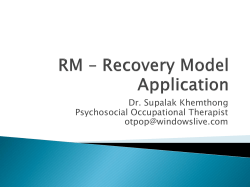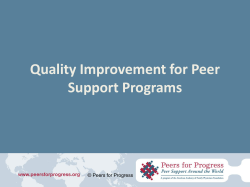
Do this right now on the handout! When you come inâ¦
Do this right now on the handout! When you come in… Take a minute to think about what kind of colleagues you would like by the end of the working year (3 adjectives) Self-assess the types of peer assessment on the sheet provided No = likely to hinder learning Yes = likely to improve learning ? = I am not sure… NZEALS International Leadership Conference 2010 Peer Learning: Developing a Culture of Collaboration Through the Use of Peer Assessment for Learning Angela Thorogood Educational Consultant/Deputy Principal Underpinning Hypotheses • Assessment for Learning can improve student learning • Apply best evidence of peer AfL from the classroom to the boardroom • Leaders can promote learning and inquiry with peer AfL • AfL can be a collaborative endeavour (Hargreaves, E., 2007) Peer Assessment OF Learning • Focused on evaluating the performance of others • Grading, marking and evaluating the work of others • Hindrances for peers may that some: 1. Prefer praise 2. Lack of skills or content knowledge 3. Are unrealistic or biased 4. Feel ethical or social influences. Peer Assessment FOR Learning • Fully integrated within regular teaching and learning activities • Allows comparing and analyzing of work • Helps foster independent learning & collaboration 1. Peer learning 2. Peer feedback 3. Peer dialogue Peer Learning •Greater benefit than working alone •Observe, collaborate, analyze, and instruct each other •Alongside a peer, focusing specifically on learning during learning •Bi-directional and reciprocal relationship Peer Feedback •Provide guidance on how to improve •Rich detailed comments •Informal rather than formal assessing •Hattie …‘dollops of feedback’ •Supported by a collaborative learning climate Peer Dialogue Active discussion which allows peers to: 1.Verbalise thinking in detail 2.Engage in debate 3.Construct arguments 4.Have greater interaction and engagement than in groups Leaders who… • Develop inquiry into practice • Promote reflection and growth • Promote learning through professional learning communities • Invest in capital development of teachers & students • Promote notions of extended professionals • Combine theory and practice Educational Leadership Theory and Peer Assessment for Learning Leaders could develop greater engagement, autonomy and learning by creating opportunities for teachers to learn, talk, give and receive feedback from each other. Thesis Research This then becomes an action research cycle for them and each term they identify small goals to work on as part of their action research, so they have their goal. They then plan how they’re going to go about achieving the goal, which is almost like their success criteria and then they go ahead and they put the plan into place. Leader 1 Research In addition, they do it with a critical friend through the action research cycle – so there is peer assessment going on. Leader 1 Peer Learning We had a partner, we paired up with someone who was either … well for me, I paired up with someone who was better. Teacher 2 Peer Learning One teacher, who had been a lead teacher in Assessment for Learning (PD), managed the whole thing and worked together with me because of our shared understandings of formative assessment and what we really wanted to get out of this. Leader 1 Peer Feedback We did a lesson for the appraisal. Your partner came to that, as well and you went to your partners. And you were part of their appraisal and so they were part of yours. Teacher 2 Peer Feedback And you had a meeting with the Deputy Principal because she was the appraiser who was writing the report but your buddy was also there talking about what they had observed in your room. Teacher 2 Peer Dialogue We had quality learning groups that we used to sit down and talk things over with. And then we used to pair off with partners and write our goals, our learning intentions – our own ones and discuss it with our partner. Teacher 1 Peer Dialogue Each term you got together with your partner and talked about what you had done to achieve your goal and what your next one was going to be for next term. Teacher 2 Hints and Tips •Peers could scaffold their colleagues learning (theory & practice) •Peers could share views, instruct each other, collaborate on improving practice •Professional Learning Communities could be enhanced by rich, detailed feedback between peers Hints and Tips •Peer feedback could be given regularly, frequent and in ‘dollops’ •Peers’ interactions could be underpinned by collaborative inquiry into theory & practice •Peers could share reflections on how to do it better next time or on what was just learnt • Go back to the original selfassessment you did at the beginning… • Reflect on what you thought then and what you think now… • So what have you learnt? • What are your next steps? • From today, what could be followed up on at a later date? • Thesis available online at Research-space • http://researchspace.itss.auckland.ac.nz Angela Thorogood M.Ed (Hons.), BA, Dip Tchg Deputy Principal Prospect School 76 Rosier Road, Glen Eden, Auckland 0602 Phone: 09 818 5219 Fax: 09 818 4780 Angelat@prospect.school.nz www.prospect.school.nz
© Copyright 2025










